We occasionally link to goods offered by vendors to help the reader find relevant products. Some of these may be affiliate based, meaning we earn small commissions (at no additional cost to you) if items are purchased. Here is more about what we do.
A good pair of kitchen shears is an indispensable tool for food prep that can serve multiple purposes.
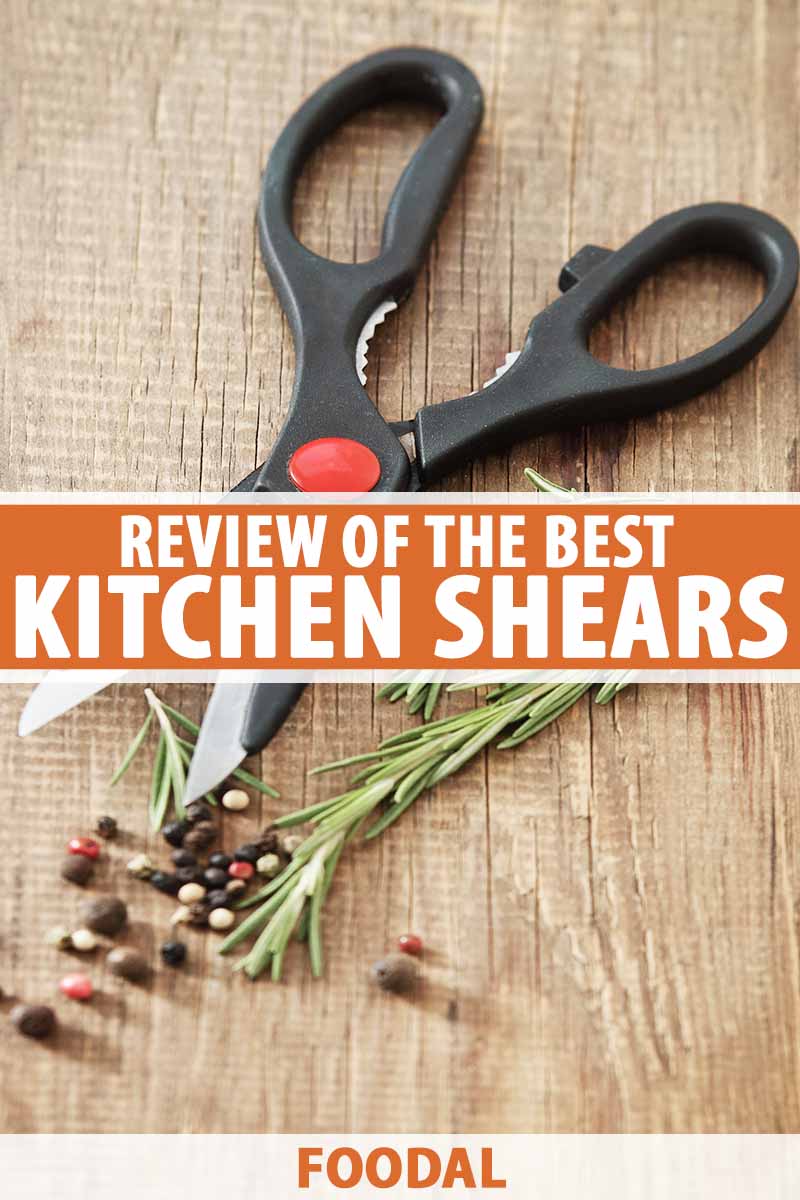
Strong and sturdy, they’re more versatile than standard scissors. The blades are sharp and precise for delicate tasks like snipping herbs and leafy greens, and tough enough to cut through dense poultry joints and small bones, or to open challenging plastic packages.
Many models have integrated gizmos like bottle opens, screwdriver tips, and nutcrackers that add extra convenience – and they’re perfect for eliminating several single-purpose tools from the junk drawer!
A staple in Korean barbecue prep and serving, they’re also handy for portioning foods for grilling season, and ideal to easily access delectable shellfish meat.
Basic or multipurpose, you’ll love having a pair in the kitchen. Join us now for a look at nine of the best kitchen shears on the market today, followed by a rundown of what makes kitchen shears different from scissors, and their various features and care requirements so you can make the best selection.
Here’s what’s covered:
9 of the Best Kitchen Shears
1. Cuisinart Multipurpose BBQ and Poultry
Cuisinart’s multipurpose BBQ and poultry shears are a handy tool for meal prep, easily handling tasks like cutting crab and lobster claws, cutting a rack of ribs, or deboning poultry.
Cuisinart Multipurpose BBQ and Poultry Shears, available on Wayfair
The sharp, curved blades are made of high-quality stainless steel that makes deep, clean cuts and a notch secures bones in place for clean precision work.
The spring-loaded plastic handles add comfort and leverage while preventing hand strain and fatigue. An easily engaged locking mechanism keeps the blades closed for storage and is released with a simple squeeze of the handles.
The Cuisinart shears measure nine and three-quarter inches in length and weigh six ounces. They come with a limited one-year warranty and are made in China. Hand wash only.
Sleek and effective, prices and customer reviews can be found at Wayfair.
2. Ergo Chef Pro Series
Our choice for the best multipurpose tool, the Ergo Chef Pro uses high-carbon German stainless steel for excellent sharpness, strength, and rust-free performance.
Ergo Chef Pro Series Shears, available on Wayfair
The sharp, durable blades feature convenient design elements like a serrated edge to firmly grasp slippery skin, a fish scaler, a vegetable peeler, and a sturdy bone-breaker notch.
Large, teardrop-shaped handles are made of ABS plastic for strength, durability, ergonomic comfort, and a secure, non-slip grip.
Other features include a bottle opener, flathead screwdriver, lid puller, and twist cap opener/nutcracker, and the blades come apart for easy cleaning and sharpening.
The Ergo Chef Pro measures eight and three-quarter inches and weighs five ounces.
These come with a limited lifetime warranty and are made in China. Hand wash and towel dry only.
Robust, handy, and highly versatile, you can find prices and check customer reviews at Wayfair.
3. Miyabi Large Handle
Miyabi’s shears are skillfully crafted of high-grade Japanese stainless steel for long-lasting sharpness and excellent cutting accuracy, and they are designed with large, D-shaped handles for a roomy, secure grip.
Miyabi Large Handle Shears, available on Zwilling
The precision-sharpened blades have an integrated bone-breaker notch, and the edges are micro-serrated to keep slippery surfaces like poultry skin in place, improving cutting accuracy and efficiency.
The distinctive, D-shaped handles are made of durable, stain-resistant ABS plastic and give ample room for comfortable use. Extra features include convenient screw cap and bottle cap openers that are integrated into the handle bases.
They have an overall length of eight and three-quarter inches and weigh four ounces.
Hand washing is recommended. Made In Japan, they come with Miyabi’s limited lifetime warranty.
Sharp and precise, customer reviews and prices are available at Zwilling.
4. OXO Good Grips Kitchen and Herb
Dependable and user-friendly, the OXO Good Grips kitchen and herb scissors are engineered with high-carbon stainless steel. Generous, soft-grip handles ensure precision cuts and an easy, secure grip.
OXO Good Grips Kitchen and Herb Shears, available at OXO
Sharp take-apart blades have one micro-serrated edge for grabbing slippery fish, meats, and poultry skin, and one straight edge for clean, smooth cuts.
The roomy, comfortable handles are made of soft, non-slip thermoplastic rubber (TPR) with extra cushioning to absorb pressure and reduce hand fatigue.
Plus, two herb-stripper notches are built into the handle base for added convenience.
The Good Grips scissors measure eight and three-quarter inches and weigh six ounces.
Hand wash only. Made in China, OXO’s lifetime satisfaction guarantee is one of the best – if damage results from deficiencies in material or workmanship, return them for a full refund or a new pair of scissors.
No frills, but these are sharp, well-built scissors. Find prices and check customer reviews at OXO.
5. Progressive Seafood
For the crustacean lover, Progressive’s seafood scissors are engineered with robust stainless steel blades to crack and cut crab, crayfish, lobster, prawns, scampi, and shrimp.
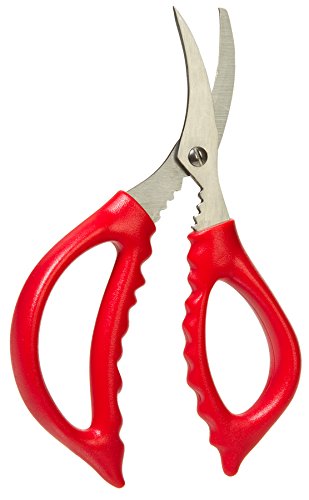
Progressive Seafood Shears, available at Amazon
The stainless steel blades are durable and sharp, with a unique curved design and pointed tip to easily cut through claws, legs, and shells to quickly release the meat. And they cleanly remove fins from fish as well.
The red ABS handles are designed for a comfortable and secure grip. And the entire inner edge, from pivot to handle tip, is ridged for cracking through hard shells of almost any size.
These scissors measure six and one-quarter inches in length and weigh one and one-half ounces. Dishwasher safe, they’re made in China and come with a limited one-year warranty.
Highly effective at quickly reducing mounds of shellfish, this is a budget-friendly must-have for your next crustacean-filled feast. Read customer reviews and check prices at Amazon.
6. Winco Detachable
A popular choice in commercial settings, Winco’s detachable kitchen shears are made of high-quality stainless steel for long-lasting sharpness, stain resistance, and strength.
Winco Detachable Kitchen Shears, available at Meat Processing Products
One blade has a micro-serrated edge to securely grasp slippery, wet proteins like chicken or fish, and the other has a clean, sharp edge for fast and efficient cutting.
The large, oval-shaped handles are made of tough and long-lasting ABS plastic and have a built-in nutcracker/twist cap opener at the base. And the blades include an integrated bottle cap opener as well.
Winco’s detachable shears measure 11 inches and weigh three and one-quarter ounces.
The detachable blades come apart for easy cleaning or sharpening and are dishwasher safe. Made in China.
Sturdy and dependable, customer reviews and prices are available at Meat Processing Products.
7. Wusthof Come-Apart
Wusthof’s robust come-apart kitchen shears are made of high-carbon stainless steel for excellent and long-lasting sharpness.
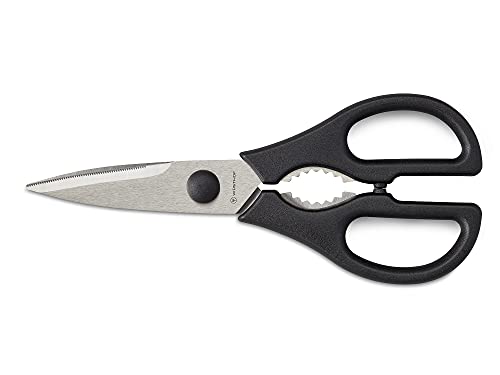
Wusthof Come-Apart Shears, available at Amazon
The high-grade steel retains a keen edge, and the blades are designed with a slight inward curve for precise, smooth cuts that are suitable for both right- and left-handed users. One blade edge is micro-serrated for improved gripping action while cutting.
A plastic cap over the pivot screw pops off to disassemble the blades for easy cleaning or sharpening, and prevents accidental separation.
The thick polypropylene handles are slip-resistant and molded for a comfortable, sure grip, and they have a nutcracker/twist cap opener integrated in the base.
They measure eight inches in length and weigh four ounces. Hand washing is recommended. Made in China, they come with a limited lifetime warranty.
Well-made and reliable, customer reviews and prices can be found now at Amazon.
8. Zwilling Deluxe Poultry
For outstanding German engineering and manufacture, the Zwilling Deluxe poultry shears have curved blades that smoothly cut through joints, rib racks, and poultry, moving easily with contours for clean, precise cuts.
Zwilling Deluxe Poultry Shears, available at Zwilling
The forged blades are made of high-carbon stainless steel and precision honed for a superbly sharp cutting edge while micro serrations provide a firm purchase on tough materials like fat and skin. An incorporated bone-breaker notch gives extra leverage for cleaving bones.
Molded plastic handles provide a comfortable grip and these are fiberglass reinforced for shatter-proof durability. A barrel spring opens the blades after each cut, and a convenient thumb-controlled sliding lock keeps them safely closed for storage.
The Zwilling poultry shears measure 10 inches, weigh eight ounces, and are dishwasher safe. Made in Germany, they come with Zwilling’s limited lifetime guarantee.
Top quality and long-lasting sharpness are key features of this pair. Prices and customer reviews can be found at Zwilling.
9. Zwilling Twin L
The sleek and sturdy Zwilling Twin L kitchen shears are designed with quality steel and superb sharpness for multiple kitchen uses, from cutting herbs and twine to opening packages.
Zwilling Twin L Shears, available at Zwilling
High-carbon stainless steel blades are ice-hardened for a strong edge that’s sharp and long-lasting. One blade is serrated for improved gripping action and the other has a straight edge for clean, exact cutting.
Roomy, reinforced polypropylene handles are durable and stain-resistant, with a seamless surface that’s contoured for an ergonomic, comfortable grip. A built-in rotary opener can be used for cracking nuts or to open screw caps.
The Twin L pair measures seven inches and weighs four ounces. Though these are dishwasher safe, handwashing is recommended. Made in Germany, they come with a limited lifetime warranty.
This pair provides excellent quality and dependable performance. Find prices and read customer reviews at Zwilling.
Shears vs. Scissors
In the mechanical world, scissors are first-class double levers consisting of three parts:
- The single-edged blades, which give the output cutting action (load).
- The handles, which deliver the input force (effort).
- A fulcrum between the blades and handles that joins and pivots the two sides.
In general, shears are designed for heavier cutting than scissors. The basic design differences between them are found in the handle shape and blade length.
Scissors typically have blades less than six inches in length, with symmetrical handles of equal size that accommodate a thumb and a single finger.
Shears have blades longer than six inches and usually have large, D-shaped handles or a combination of circular and D handles – the smaller or circular one is for the thumb while the larger handle fits two to four fingers.
However, the kitchen variety is an exception to the blade length rule, and it has shorter blades of three to five inches. This results in extra leverage in the handles, which provides the force needed to accurately slice through tough materials.
Also, the handles are often offset to provide a smooth, comfortable cutting action on a counter or chopping block.
And in case you’re wondering, the correct terminology is a pair of scissors – grammatically, they’re considered a single object that uses a plural form!
Features for Consideration
Shears can be plain-Jane and basic, or they can be loaded with additional features for greater performance and added convenience.
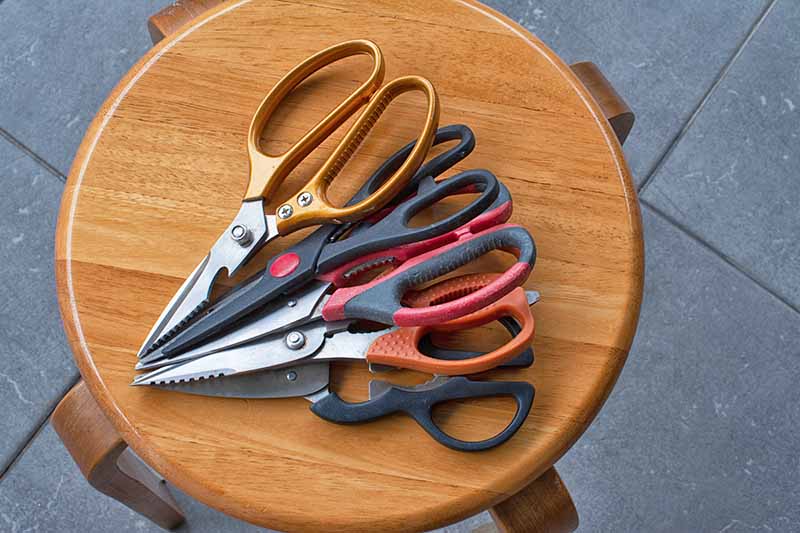
Let’s take a look at the features you’ll see in the various models available today, starting with the materials the blades are made from.
Carbon Steel vs. Stainless Steel
Professional-grade pairs may be made of carbon steel. Compared to stainless steel, it takes a sharper edge, holds an edge better, and is easier to sharpen.
But carbon steel rusts easily. If it’s not coated with a layer of chrome, nickel, or stainless steel, regular maintenance with oil is required.
Shears for the home market are usually made of stainless steel, selected for its durability and excellent rust and stain resistance.
To enjoy the best traits of both materials, look for brands that use high-end stainless steel alloys developed to mimic the traits of carbon steel such as hard cutting edges, edge retention, and sharpness.
Handle Comfort and Grip
For extended use or for work with hard materials, look for handles made of rubber or ABS plastic that provide cushioned comfort and a safe, slip-resistant grip.
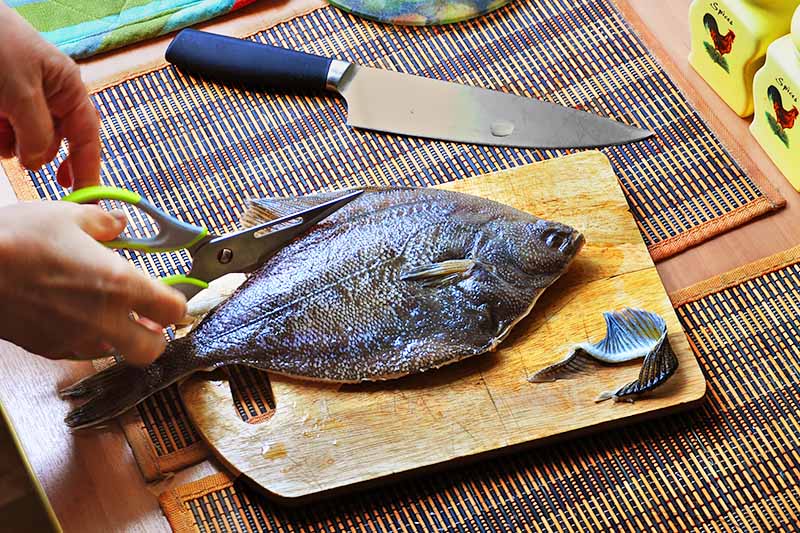
Also, select a pair that best suits your hand size and shape, and that provides a roomy grip.
Left- or Right-Handed Use
Left- or right-handed use is determined by which blade lifts up when the levers are opened.
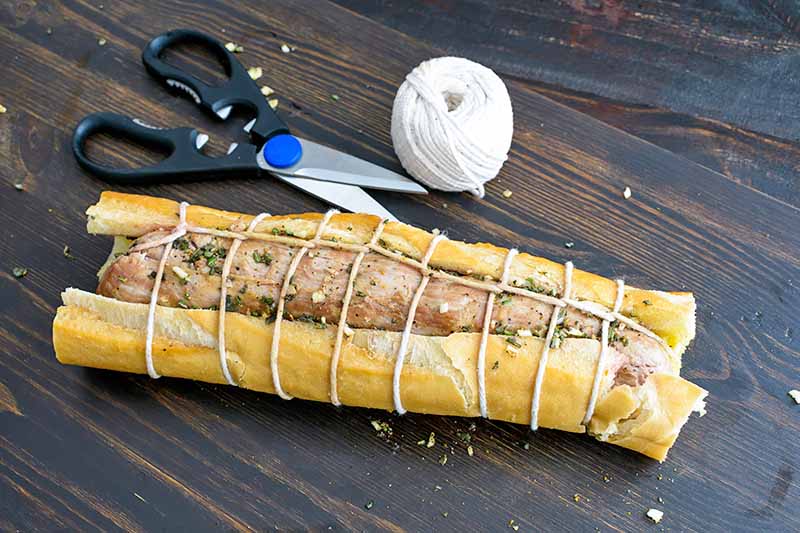
On right-handed pairs, the blade on the right side always lifts up and the left blade always drops down – this is true even when they’re flipped over.
On left-handed pairs, the blade on the left always lifts up and the right blade always drops down.
When the handles of a pair of scissors are squeezed, the two cutting edges are pressed together – the cut happens where the blades meet. But when held in the non-dominant hand, the squeezing action actually pushes the blades apart, resulting in off-center, messy cuts.
True ambidextrous scissors require double-edged blades with handles that can be rotated 180 degrees – not exactly the most convenient design.
Symmetrical handles can make it easier for lefties to use right-handed scissors, however, the cutting line will always be blocked by the top blade and the opposing pressure will always open the blades to a certain degree.
For lefties to use right-handed scissors, look for ones constructed with slightly curved blades that resist pulling apart and maintain a cutting contact point.
Lower Pivot Point
Unlike most other types of shears, those used in the kitchen have proportionally shorter blades.
The shorter blades allow a lower fulcrum, which gives greater leverage and maneuverability for cutting through dense materials such as bone, cartilage, and joints.
Multiple Functions
Kitchen shears often have additional features such as a bottle opener, a ridged rotary grip for cracking nuts and shells or opening twist caps, a bottle opener, a screwdriver tip, and so on.
Convenient and handy in the kitchen, the extra features help to reduce the need for a number of single-use tools that take up extra kitchen space. All shears do not act as multi-tools, but if this is something that interests you, be sure to keep an eye out for specific features that will meet your needs.
One-Piece Construction
Kitchen shears are often given tough tasks to handle, like opening clamshell packages, prying open lids, or cutting through dense bones, connective tissue, and joints.
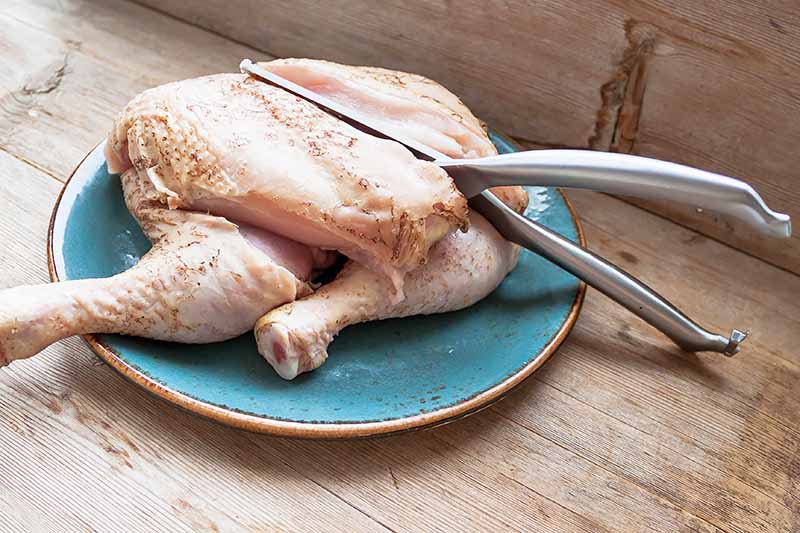
For sturdy performance, look for brands that use one-piece construction with a single blade and tang that extends fully into the handle. A full tang prevents handles from breaking or twisting when cutting through tough, challenging material.
Separating Blades
Separating, or come-apart, blades are designed to come apart for easy cleaning and sharpening.
One blade has a contact notch that slips over the stationary pivot point on the other blade, and a twist locks the two blades together.
To separate, twist in the opposite direction to release the blades.
Spring-Loaded Action
Some pairs come equipped with spring-loaded action that automatically pushes the handles apart after a cut.
This helps to reduce hand fatigue, but because of the spring, some effort is needed to close the blades – which is then converted into cutting energy.
Barrel, compression, flat, and torsion springs are typically used, either located at the base of the handles or integrated into the pivot screw.
Those with a spring typically have a sliding lock or latch to keep the blades closed safely for storage.
However, it should be noted that springs create a welcome environment for food particles to collect and bacteria to breed – extra care should be taken to thoroughly clean the spring area after each use.
Serrated Blade Edge
Several brands have incorporated micro-serrations along the cutting edge of one or both blades.
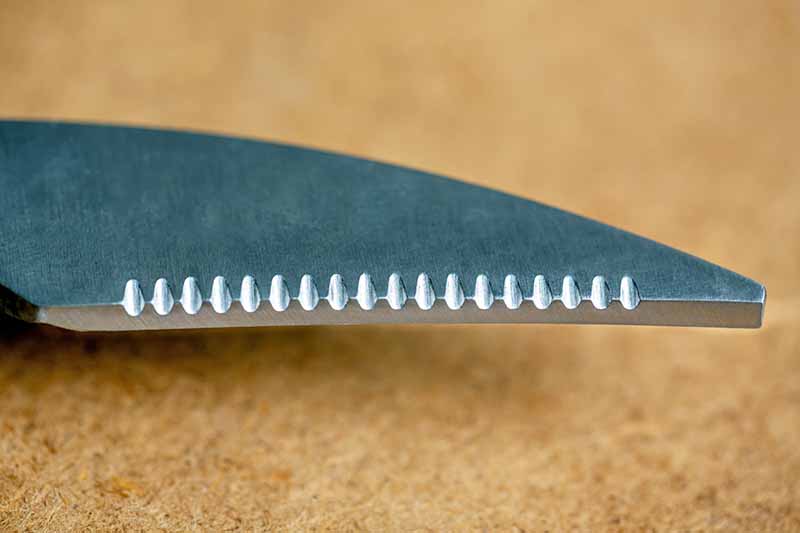
This provides a better grip on slippery materials like fish, poultry skins, and silver skin when cutting.
Care and Maintenance
While most pairs made of stainless steel are dishwasher safe, hand washing is recommended to retain sharp cutting edges.
For blades constructed of carbon steel, wipe with a lightly oiled cloth after each wash and dry promptly.
Using food-safe mineral oil is best. This 12-ounce bottle from Thirteen Chefs can also be used to condition cutting boards. It is available at Amazon.
Occasionally add a drop of oil to the pivot screw as well, to keep the action smooth and easy.
Sharpen as needed, using a sharpening stone, an electric sharpener, or a countertop sharpener that accommodates scissors.
The Sharpal system uses a scissor-specific tungsten carbide blade to keep cutting edges sharp. It is available at Amazon.
A Cut Above
Available in a range of sizes, kitchen shears can be basic like scissors, specialized for specific tasks like cutting poultry or shellfish, or they may include a variety of features for multiple functions.
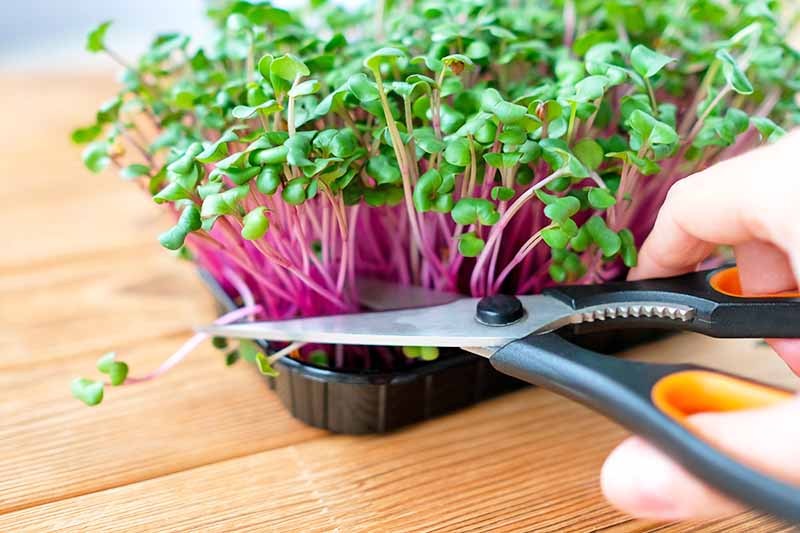
Look for shears made of high-grade stainless steel for sharp, durable cutting edges and handles that provide ample room for a comfortable, safe grip.
Then enjoy the convenience of this versatile tool for a myriad of food prep tasks!
Which model is the best fit for your kitchen? Let us know in the comments below.
And for more info on essential kitchen gear, add these articles to your reading list next:
- The Best Microplanes and Zesters for Your Home
- Make Healthy Vegetable Noodles with a Spiralizer
- Guide to Salad Spinners: 11 of the Best Models
© Ask the Experts, LLC. ALL RIGHTS RESERVED. See our TOS for more details. Product photos via Amazon, Wayfair, Zwilling, OXO, and Meat Processing Products. Uncredited photos via Shutterstock. Originally published on January 20, 2020. Last updated on February 20, 2022.
About Lorna Kring
Recently retired as a costume specialist in the TV and film industry, Lorna now enjoys blogging on contemporary lifestyle themes. A bit daft about the garden, she’s particularly obsessed with organic tomatoes and herbs, and delights in breaking bread with family and friends.


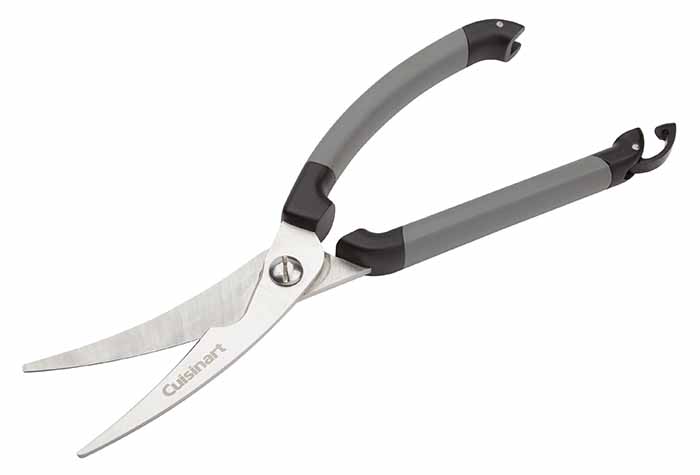
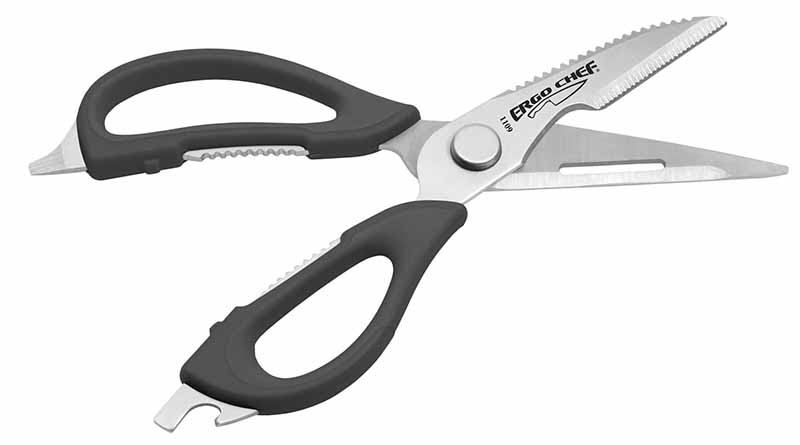
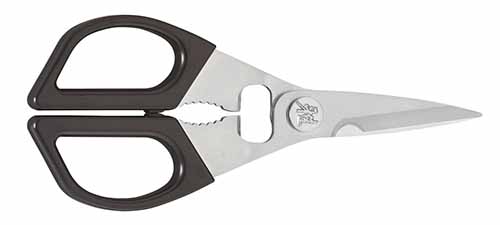
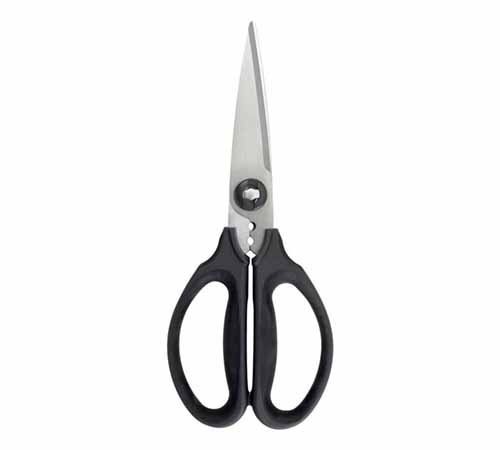
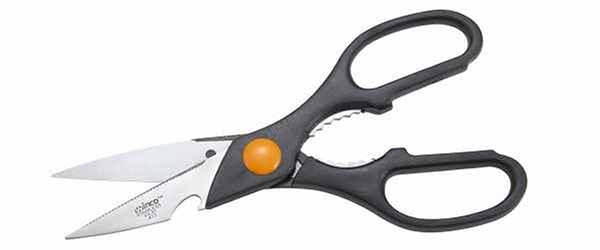
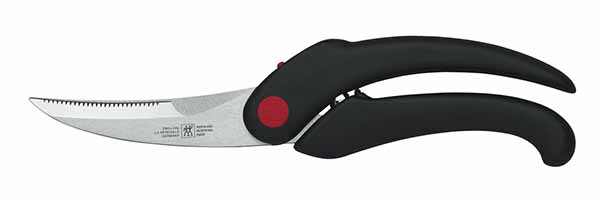
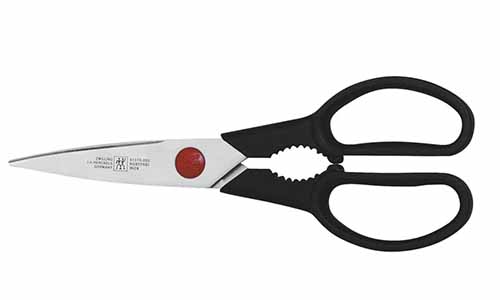
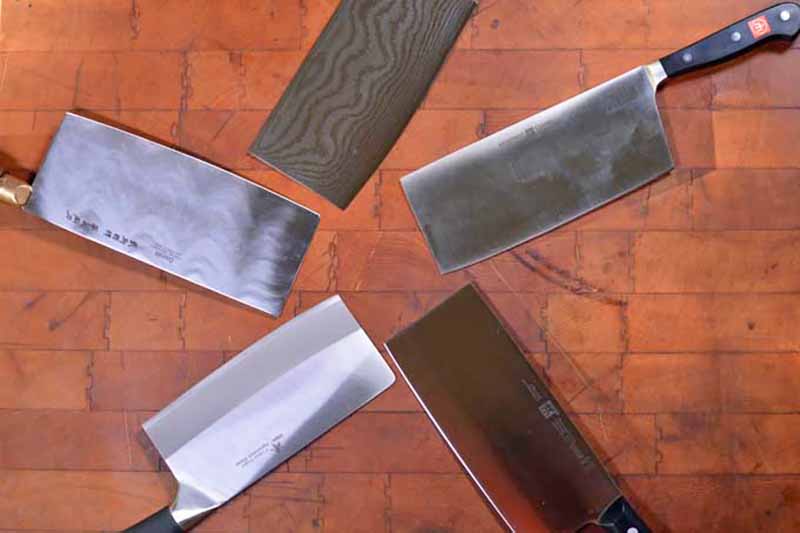
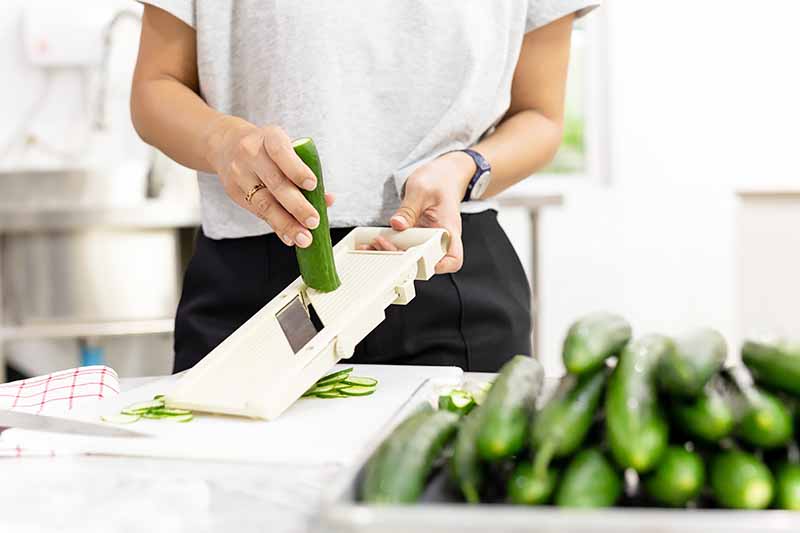

We have a pair of kitchen scissors that i never use for anything other than opening things. I know that that is not what they are used for but i never knew what. I saw a commercial where they where cutting fish with them and i had an idea but that was eaelier today. I was shocked honestly. I did not think that they were that strong. Well now I know.
Good ones are that strong lachris15, and are a great tool in food preparation.
Great article! We have kitchen shears, and I have to admit that I almost never use them. I probably use them to open packages far more often than I used them to cut foods, which is a shame. The next time I need to cut up some foods in the kitchen, I will actually bust them out!
It is pretty easy for them to get shoved to the back of the junk drawer troutski, but once you get into the habit of using them, you’ll love how well they perform. Especially on slippery foods like fish and chicken.
To tell the truth, I’ve never used kitchen shears and I think I could use a pair. It might take me a bit to get accustomed to cutting certain items rather than slicing them, but I could see it being super convenient in many cases. Plus I had no idea they could cut through bone or cartilage. You learn something new every day 😀
They do take a bit of getting used to, but once you do you’ll wonder how you got on without them. And they’re great for cutting through the cartilage and joints of a slippery chicken etc.
I have shears that came with my knife set, but they haven’t impressed me, so I will probably end up purchasing a set. This is quite a comprehensive article/review, and I see several that interest me. I’m glad you to see the article addresses left handedness and ergonomics, since those are two issues of importance to me.
It seems to be an important issue for a lot of cooks Diane, and it’s nice to see the manufacturers respond to issues of comfort, hand strength and left-handedness. And it seems that most shears that come with a knife set are a bit on the flimsy side, good for cutting up packaging but not for tackling tougher challenges.
I keep thinking I should get a pair. My mother always had some. All of these look nice. I’ll have to study up on them a bit, using your handy guide. I can think of so many things I could use them for. I don’t know why I haven’t purchased a pair by now. It would make kitchen life easier.
Thanks for posting such a well done guide and review. You’ll make choosing easy for me.
Glad you found the post useful Zyni, let us know of your recommendation when you do make your choice.
I use them all the time. In many cases they are much safer and easier to use than a knife. I can’t imagine going without them. They are a must have in my kitchen.
Much safer when cutting through tough or slippery things like a chicken or cartilage. They’re a staple in utensil bin!
I must admit I use kitchen scissor all. the. time. I have three pairs so that I always have a pair ready to use and clean. My favorite pairs are a new Pridebit multifunctional and a vintage Wiss pair with turquoise enamel handles that I just adore. I use them not just for meat and herbs but every day jobs that are much less messy this way like cutting pizza. And of course they also do non-food related duty like opening bags, boxes etc. Yes, I always clean them carefully between uses!
In terms of food safety I would strong recommend that anything that might be a bacterial risk (e.g. meat, leafy greens) be cut with scissors where you can separate the tines (like with the model you show) and wash them that way, it prevents and nasties hiding away in the hinge and not getting killed in the wash, whether you do it by hand or put it in the dishwasher.
Thanks for commenting Portia, your insights are appreciated.
I love this informative post on using scissors for food prep. I am guilty of having used them for things other than food. Who knew how handy they were?
Nothing wrong with using them for other things Jasmine, they just need to be cleaned before using on food. They’re a great kitchen tool!
I absolutely love my shears. I have a pair from Cutco. I use them for cutting meat that’s too slippery to cut with a knife, cutting herbs, cutting open plastic, and even for cutting pizza. They’re fantastic. They come apart for easy cleaning or box opening.
Thanks for sharing littlefoodie, I’ll have to check out the pair that you’re using. I just love these for slippery meat, especially chicken – takes away the worry about lopping off a fingertip!
This is a great article! I never knew what these were called, I’ve always thought they were scissors. Now, I know better! Yes, I had Korean BBQ before and never knew why they had to use scissors to serve us. I thought it was silly, but at the same time quite smart. Something you get things done a lot faster if you don’t need a knife and a cutting board. I’m also amaze by all the different types of shears. I never knew that there was one that had Carbon handle! I really want one of those, but they are pretty pricey!
It’s just a matter of getting used to them Tipes, and once you do they make a lot of kitchen work faster and easier.
My mantra with any tools, be they for the kitchen, art, or garden, is to get the best I can afford at the time. It’s an investment that pays back in easier tasks with greater results – when they’re looked after properly that is!
I have a pair of kitchen shears that came with my knife set but after reading this I think I might look into getting myself a higher quality pair. I use them to cut the burnt edges off my garlic bread all the time and I’ve just recently started cutting bacon with them too. I always thought I was doing something I wasn’t supposed to by using them on food though, I never realized that was their purpose! I always have a hard time chopping up my fresh herbs as fine as I’d like them so I’m excited to try this technique instead…I have a feeling I’m going to be testing out my kitchen shears on everything for the next couple days!
They can be used on any food items cupcakekitty, just be sure to give them a thorough cleaning between uses.
Growing up, whenever I needed a pair of scissors in the kitchen for non-cooking uses I would always grab a pair of shears. This often resulted in me getting yelled at for using kitchen shears on arts and craft project (how was I suppose to know there was a difference?!). It wasn’t until I got older and was able to help out around the kitchen when I realized…hey, there really was a difference!
Since having my own place and kitchen, I’ve been noticing that there always seems to be something missing…and it turns out, I only have a pair of regular cutters instead of specialized, fancy kitchen cutters! It is definitely on the list of things I plan on buying the next time I do some home product shopping…that way I can cut up my roasted chicken without wrestling with it first!
Lol! There is a difference indeed tangela21, and dull kitchen shears seem to be more frustrating than none at all! Hope you find a good pair to fill that missing ‘something’ in your kitchen…
I am so stoked about this information. I am and have been in the market for shears. I have been cutting my lobster tails open with a knife. It bugs me that every time I cook them, that is when I remember I’ve yet to purchase some shears. Cutting lobster open with a knife is not pretty and it is a hassle. These suggestions are spot on for me. I really like the Tojiro-pro. They look so fancy. I think this would be awesome for my short ribs too. Hmmm. I’m seeing endless possibilities now.
They’re wonderfully versatile niquelene, and it seems the more they get used, the more inspired the user! Glad you found the post useful!
Ooooh, interesting. All of the articles here are very detailed and informative, I’m impressed. 🙂
I’m not feeling too smart right now, I’ve had a pair of shears for years now (they look exactly like the Wusthof 5558-1 Come-Apart Kitchen Shears) and I have only been using them to cut open milk bags, thinking they were over-sized scissors.. Cutting poultry has always resulted in disaster for me, so I guess I have a new method now.
I just had one question, is there a very significant difference in the cut quality and the lifespan of carbon steal shears and stainless steel ones? I wonder if it’d be more expensive to buy one good pair that lasts longer, or a few lower quality ones that are cheaper to replace.
Personally Hannah, I would go for stainless steel over carbon just because of the rust/staining factor with the carbon steel. And try to get a pair of decent quality – for me, it isn’t about the cost of having to replace inexpensive shears, it’s about the frustration of using a set that won’t perform as I expect them to. Hope that helps!
Honestly these shears look so affordable and useful…it is almost sad to admit I have never used shears to cut food before. Maybe I used them to cut open a bag of frozen veggies or something of that nature…but never to cut food. I have to admit it seems like effortless cooking.
They seem to be one of those tools that become more useful the more they’re used sheebah7. And if they’re not used, they’re ‘out of sight, out of mind’… but they do make for effortless cooking with a lot of tasks!
Growing up, my mother never had a standard pair of kitchen shears to do anything with in the kitchen other than opening a stubborn package or bag. However, I recently bought a decent pair and use them for lots of things. The are great for cutting up celery and herbs and have even been handy when I misplace my pizza cutter.
They’re pretty useful when you get a decent pair Lisa… and very versatile!
Well, ladies (and men too if any are reading this great post) here is another “off the beaten path” use for kitchen shears. I pack them in with my hunting gear to field clean small game. Great for small bones, skinning, and related imaginative uses. And yes, fishing falls in this category too. A great tool. I’ve had my no-name shears for almost fifty years now. My wife has her own shears for brutal kitchen use.
Thanks for the tips Mike, they’re a versatile tool indeed!
A lot of fancy scissors on this list, but unlikely that any will outperform the $1.49 Daiso stainless steel crab scissors. Yes, that’s right – $1.49. You see them marked up to $8, or even $26 online, but you can walk into any Daiso and buy them off the rack for $1.49. Amazon sells them at two for $14.
The flat-edge design on those scissors is centuries old! It’s time for chefs to appreciate modern advances in cutting technology. The curved blade design of the crab scissors allows for a big increase in cutting leverage – more cutting power with less effort. A similar design has been adopted by Staples on its newer premium office scissors, and by Fiskars on newer garden shears.
Try them out, and then tell me which kitchen scissors cut and clean easier.
Haven’t tried the scissors that you mentioned, but I love Daiso! I agree- they have lots of useful kitchen gadgets at affordable prices. Definitely worth a look if you have one in your neighborhood. You make an interesting point about the curved design as well.
Though I have numerous different types dollar stores in my neighborhood that sell a variety of good decent goods would you suggest or recommend buying Family Chef kitchen shears from a store like Family Dollar? I could walk to at least one dollar type store but I need to be in the mood to walk that far. Family dollar is just across the street from where I live. The other store is a good walk away from where I live. Stuff sold in stores like this tend to not express on quality more like quantity which means you get what you pay for. But often times store products like those sold in those stores tend to last seemingly forever.
I’m not familiar with the Family Chef brand, so I cannot recommend it from firsthand experience. Overall, I agree that you typically get what you pay for- though finding the occasional dollar store gem certainly isn’t out of the question, the products and brands that we recommend are typically noted for their quality and lasting power in the kitchen.
If you do give these a shot, let us know what you think!
Seconded (or is this fourth-ed?)! Bought the first pair because they were cheap, and then later two more just because they were so damned good. The best part is how they separate easily (for cleaning, which is essential to those of us washing everything by hand) but never accidentally (due to excellent design on the locking mechanism). I think I’ve had the first pair for five years now, and although the plastic handle has faded, it hasn’t even cracked. Both pairs still going strong and should last another 3 years, at least. Haven’t seen them in Daiso for a while, so if you are fortunate enough to find any, BUY THEM.
I have a kitchen scissor & i use it also for cutting fish & vegetable, but now i know i can do other many more things by it. Thanks a lot for this very informative article.
For those considering the Kershaw Taskmaster, please be advised the newest version (Taskmaster 1121) is no longer manufactured in Japan.
Unfortunately, Kershaw has not been transparent when it comes to providing information on the exact type of stainless steel used in the latest Taskmaster 1121 shears, as well as the previous Made in Japan 1120 model. Given the fact that there are various grades of stainless steel, having this information readily available in the spec sheets would allow consumers to make better informed decisions
Sadly, consumers are left in the dark, and must draw their own conclusions as to whether there are any material differences between the MIJ and Made In China versions of the Kershaw Taskmaster.
The fact that a set of shear’s handles are symmetrical don’t make them ambidextrous. It does not make any difference for right or left-handed people.
Right-handed scissors fail for left-handed people because they force the blade’s edges apart when using the left-hand as opposed to the right. That’s because most shears/scissors cross their blades for right-handed people. Regardless of how you grip them, the blades will always cross the same way: Left blade going up, right blade going down. Left-handed shears cross their blades in the opposite direction and will fail for right-handed people
The only way to make them as ambidextrous as possible is for them to have blades slightly curved inward, so when a left-handed person used it, they will not separate and cut well.